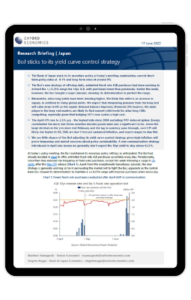BoJ sticks to its yield curve control strategy

The Bank of Japan stuck to its monetary policy at today’s (17 June) meeting, maintaining current short-term policy rates at -0.1% and long-term rates at around 0%.
The BoJ’s new strategy of offering daily, unlimited fixed-rate JGB purchases had been working to defend the +/-0.25% range for 10yr JGB, with purchases lower than previously. Earlier this week, however, the BoJ bought a larger amount, showing its determination to protect the range.
What you will learn:
- Meanwhile, ultra-long yields have been trending higher. We think this reflects an increase in supply, in addition to rising global yields. We expect that steepening pressure from the long end will calm down in H2 as the supply-demand balance improves.
- The April CPI rose to 2.5% y/y – the highest rate since 2008 excluding VAT-induced spikes. Given the large declines in the yen since end-February and the lag in currency pass-through, core-CPI will likely rise higher in H2. Still, we don’t forecast sustained inflation, and expect wages to stay flat.
- We see little chance of the BoJ adjusting its yield curve control strategy given high inflation will prove temporary and muted concerns about policy sustainability. A new communication strategy introduced in April also means we generally don’t expect the 10yr yield to stay above 0.25%.
Tags:
Related posts

Post
How Asia’s supply chains are changing | Techonomics Talks
Global supply chains have continued to expand, despite talk of deglobalization and nearshoring. US and Japan have started to de-couple from China, but other G7 countries grow more dependent on Chinese inputs. Several "hotspots" are emerging across Asia with multiple winning formulas.
Find Out More
Post
BoJ to raise its policy rate cautiously to 1% by 2028
We now project that the Bank of Japan will start to raise its policy rate next spring assuming another robust wage settlement at the Spring Negotiation. If inflation remains on a path towards 2%, the BoJ will likely raise rates cautiously to a terminal rate of around 1% in 2028.
Find Out More
Post
Japan inflation to rise to 1.8%, but downside risks are high
Reflecting a surprisingly strong Spring Negotiation result and weaker yen assumption, we have upgraded our baseline wage and inflation forecasts. We now project higher wage settlements will push inflation towards 1.8% by 2027. Uncertainty is high, however.
Find Out More